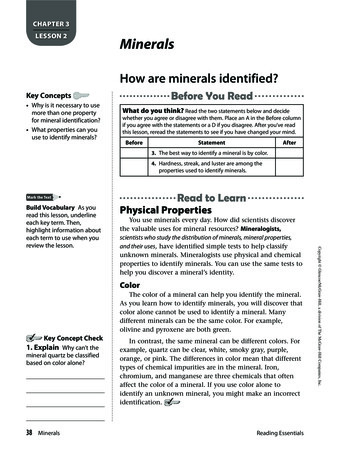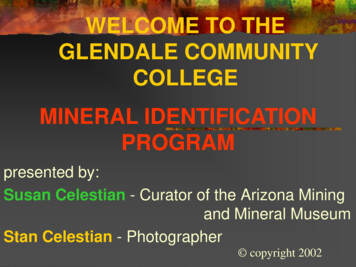
Transcription
CHAPTER 3LESSON 2MineralsHow are minerals identified?Key Concepts Why is it necessary to usemore than one propertyfor mineral identification? What properties can youuse to identify minerals?What do you think? Read the two statements below and decidewhether you agree or disagree with them. Place an A in the Before columnif you agree with the statements or a D if you disagree. After you’ve readthis lesson, reread the statements to see if you have changed your mind.BeforeStatementAfter3. The best way to identify a mineral is by color.4. Hardness, streak, and luster are among theproperties used to identify minerals.Physical PropertiesYou use minerals every day. How did scientists discoverthe valuable uses for mineral resources? Mineralogists,scientists who study the distribution of minerals, mineral properties,and their uses, have identified simple tests to help classifyunknown minerals. Mineralogists use physical and chemicalproperties to identify minerals. You can use the same tests tohelp you discover a mineral’s identity.ColorThe color of a mineral can help you identify the mineral.As you learn how to identify minerals, you will discover thatcolor alone cannot be used to identify a mineral. Manydifferent minerals can be the same color. For example,olivine and pyroxene are both green.Key Concept Check1. Explain Why can’t themineral quartz be classifiedbased on color alone?38MineralsIn contrast, the same mineral can be different colors. Forexample, quartz can be clear, white, smoky gray, purple,orange, or pink. The differences in color mean that differenttypes of chemical impurities are in the mineral. Iron,chromium, and manganese are three chemicals that oftenaffect the color of a mineral. If you use color alone toidentify an unknown mineral, you might make an incorrectidentification.Reading EssentialsCopyright Glencoe/McGraw-Hill, a division of The McGraw-Hill Companies, Inc.Build Vocabulary As youread this lesson, underlineeach key term. Then,highlight information abouteach term to use when youreview the lesson.
LusterThe way that a mineral reflects or absorbs light at its surface is calledluster. The surfaces of minerals that are metals, such as copper,silver, and gold, reflect light. This produces the shiniest luster,called metallic luster. Nonmetallic minerals have luster thatmight also be shiny but are not as reflective as a metal. A cutand polished diamond has brilliant luster. A mineral’s lustermight also be described as waxy, silky, pearly, and vitreous(VIH tree us). A vitreous luster appears glassy. Minerals thatdo not appear shiny are called earthy or dull. Luster is aresult of the chemical makeup of the mineral.Make a half-book to helpyou describe the physicalproperties used foridentifying minerals.rCleoalovageCHardnessPhysPropeicalof rtiesMineralsStreakSome minerals, such as graphite, produce a powder whenscratched. Rubbing a mineral across an unglazed porcelainplate will sometimes leave a colored streak on the surface ofthe plate. Streak is the color of a mineral in powdered form. Streak isuseful only for identifying minerals that are softer thanporcelain. Nonmetallic minerals usually produce a whitestreak. Many metallic minerals are easy to identify because oftheir streak color. Some minerals vary in color but have astreak that is always the same color.Copyright Glencoe/McGraw-Hill, a division of The McGraw-Hill Companies, Inc.HardnessStreak relates to a mineral’s makeup and hardness.Hardness is the resistance of a mineral to being scratched. FriedrichMohs, a German mineralogist, developed a scale to comparethe hardnesses of minerals. The Mohs scale ranges from 1 to10. Talc is the softest mineral on the scale. It has a hardnessvalue of 1. Diamond is the hardest mineral with a hardnessvalue of 10.Reading Check2. Explain How are streakand color related?Testing Hardness The mineral quartz has a hardness of 7.This means that when a piece of quartz is rubbed across thesurface of a mineral with a hardness less than 7, the quartzwill scratch the mineral. Quartz will scratch feldspar, calcite,and talc because each has a hardness less than 7. Quartz willnot scratch topaz, corundum, or diamond because they eachhave a hardness greater than 7.Comparing Hardness Mineralogists use ordinary objectssuch as steel and glass to test the hardness of unknownminerals. The hardness of a steel file, a piece of glass, apenny, and your fingernail are known. These objects areincluded on the Mohs scale. An unknown mineral thatscratches a penny but not quartz has a hardness between3 and 7. If that unknown mineral does not scratch glass,the mineral’s hardness is between 3 and 5.5.Reading Essentials3. Evaluate Why do youthink mineralogists addedordinary objects to the Mohshardness scale?Minerals39
Mohs Hardness Scale for MineralsMineralHardnessTalc1 (softest)Hardness of Common ObjectsGypsum2fingernail (2.5)Calcite3penny (3.5)Fluorite4iron nail (4.5)Apatite5glass (5.5)Feldspar6steel file (6.5)Visual CheckQuartz74. Identify Circle theTopaz8minerals shown in the tablethat are hard enough toscratch glass.Corundum9Diamond10 (hardest)Look at the Mohs hardness scale above. It lists ten commonminerals. Each has been assigned a hardness value. Somecommon objects and their hardness values are also listed.Cleavage and Fracturecleavagefrom Old English cleofan,means “to split, separate”Other minerals, such as the one shown below on theright, break unevenly because their bonds are equally strongthroughout. If a mineral breaks to form uneven surfaces, it hasfracture. Not all fracture patterns are predictable. Someminerals fracture into splinters or fibers. Others, such asquartz, break like thick glass with smooth and curved surfaces.Visual Check5. Identify Write cleavagebelow the correct mineralon the right that showscharacteristics of cleavage.40MineralsReading EssentialsCopyright Glencoe/McGraw-Hill, a division of The McGraw-Hill Companies, Inc.WORD ORIGINSometimes the way a mineral breaks helps identify it. Thearrangement of atoms or ions and the strengths of the bondsbetween atoms determine how a mineral breaks. Mineralsbreak where bonds between atoms or ions are weak. If amineral breaks with smooth, flat surfaces, it has cleavage. An exampleof cleavage is shown in the figure below. The mineral on theleft forms a flat surface where it breaks. This characteristichelps identify the mineral.
DensityA bowling ball and a volleyball are about the same size.But a bowling ball is heavier than a volleyball. Why is thevolleyball lighter? The volleyball is lighter because it is lessdense than a bowling ball. The density of an object is equal to itsmass divided by its volume (g/cm3). A bowling ball has a greaterdensity than a volleyball. The volumes of both balls arealmost equal, but the mass of the bowling ball is greater. Bymeasuring the mass and the volume of any object, you cancalculate the object’s density.You can compare the densities of two different mineralsthat are about the same size without having to measure theirmass and volume. Hold one mineral in each of your hands.The one that feels heavier is the one with greater mass and agreater density. With practice, you will be able to identifycertain minerals based on how heavy they feel.Special PropertiesCopyright Glencoe/McGraw-Hill, a division of The McGraw-Hill Companies, Inc.Some minerals have special properties that help you toidentify them, as shown in the table below. For example,graphite feels greasy when you touch it, but talc feelssmooth. Some minerals react when they come into contactwith certain substances. Other minerals can be identified bytheir odors, by their magnetic properties, or by their reactionto light. For example, fluorescence is a mineral’s ability toglow when exposed to ultraviolet light.MineralSpecial PropertiesCalcitefizzes and produces gas when it contactshydrochloric acid; can fluoresceFluoritecan fluoresceGraphitefeels greasyKaolinitesmells like clayMagnetiteis magneticSulfursmells like a matchTalcfeels smoothReading Check6. Distinguish What is aneasy way to decide whichone of two minerals has agreater density?Key Concept Check7. Identify all theproperties used to classify anunknown mineral.Visual Check8. Identify Name the twominerals in the table thathave similar specialproperties.Reading EssentialsMinerals41
Mini Glossarycleavage: the breakage of a mineral along smooth, flat surfacesluster: the way a mineral reflects or absorbs light at its surfacedensity: the mass of an object divided by its volume (g/cm3)mineralogist: a scientist who studies the distribution offracture: the breakage of a mineral to form uneven surfacesminerals, mineral properties, and their usesstreak: the color of a mineral in powdered formhardness: the resistance of a mineral to being scratched1. Review the terms and their definitions in the Mini Glossary. Write a sentence thatdescribes how minerals can be identified using luster.2. Suppose you have three objects—A, B, and C—that are made of unknown materials, andyou test their hardness. Object A scratches gypsum but does not scratch fluorite. Object Bscratches object A, but not feldspar. Object C scratches objects A and B, but not quartz. Placeobjects A, B, and C in the chart close to where they would be ranked in hardness.Hardness te5Feldspar6Quartz7Copyright Glencoe/McGraw-Hill, a division of The McGraw-Hill Companies, Inc.TalcHardness of Unknown Objects3. Explain the difference between fracture and cleavage.What do you thinkReread the statements at the beginning of thelesson. Fill in the After column with an A if youagree with the statement or a D if you disagree.Did you change your mind?42MineralsConnect EDLog on to ConnectED.mcgraw-hill.comand access your textbook to find thislesson’s resources.END OFLESSONReading Essentials
10. Talc is the softest mineral on the scale. It has a hardness value of 1. Diamond is the hardest mineral with a hardness value of 10. Testing Hardness The mineral quartz has a hardness of 7. This means that when a piece of quartz is rubbed across the surface of a mineral with a hardness less than 7, the quartz will scratch the mineral.










